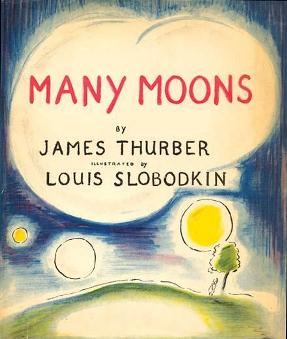Many Moons facts for kids
 |
|
| Author | James Thurber |
|---|---|
| Illustrator | Louis Slobodkin |
| Country | United States |
| Genre | Children's picture book |
| Publisher | Harcourt, Brace & Company |
|
Publication date
|
1943 |
| Pages | 48 pp |
| ISBN | 0156569809 |
Many Moons is a classic children's picture book. It was written by James Thurber and illustrated by Louis Slobodkin. The book was first published in 1943. It even won a special award called the Caldecott Medal in 1944. This award is given to the artist of the most outstanding American picture book for children. The story is about a princess who gets sick. She believes only the moon can make her feel better. Unlike some of Thurber's other stories, this one has a happy ending for everyone involved.
In 1990, the book was reprinted. This new version had different illustrations by Marc Simont.
Contents
The Story of Princess Lenore
Princess Lenore ate too many raspberry tarts. She felt very sick and insisted she would only get better. She said this would happen if her father, the King, brought her the moon.
The King's Problem
The King was worried. He asked the wisest men in his court for help. He wanted to know how to get the moon for his daughter. But the wise men all said it was impossible. They claimed the moon was too big and too far away. They also said it was made of strange or dangerous things.
The King felt very sad and hopeless. He then decided to talk to his court jester. The jester was known for being clever and funny.
The Jester's Clever Idea
The jester went to Princess Lenore. He asked her what she thought the moon was like. The princess said the moon was as small as her thumbnail. She also believed it was made of gold. She thought it was so close that someone could climb a tree and pick it from the sky.
The jester promised the princess he would get the moon for her that very night. Instead, he went to the royal goldsmith. He told the goldsmith exactly what the princess had described. The goldsmith then made a beautiful necklace. It had a small, golden, moon-like pendant. This necklace was given to the princess. She immediately felt much better!
The Moon's Secret
The next day, the King was worried again. He feared the princess would see the real moon in the sky. Then she would know the necklace was not the actual moon. He asked his wise men for advice. They came up with many wild and silly plans to hide the moon.
Finally, the jester visited the princess. She was happily looking at the newly risen moon in the sky. He asked her how the moon could be in two places at once. The princess smiled. She told him that the moon always grows back. She said it was like a child's tooth, a unicorn's horn, or flowers.
Other Versions of the Story
"Many Moons" has been turned into other forms of entertainment.
- An American composer named Celius Dougherty made it into an opera.
- It was also adapted into a play by Charlotte Chorpenning.
- In 1966, an animated cartoon version was made. This was part of a film called Alice of Wonderland in Paris by Gene Deitch.
- In 1972, an audio version was released. It was read by Peter Ustinov with music by Edgar Summerlin.

